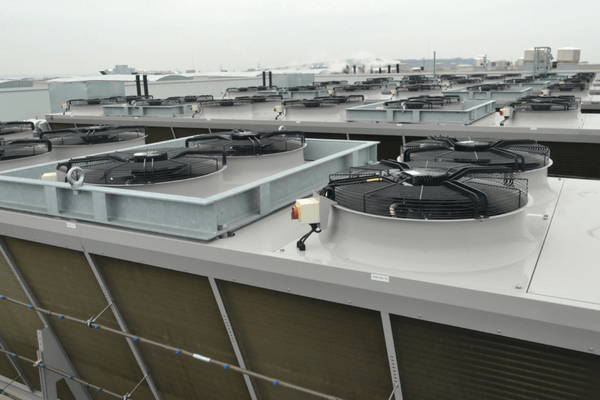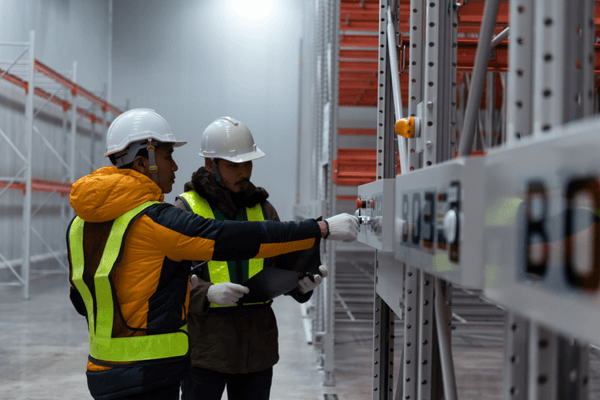 |
Written by Liz McDermott |

Ammonia is a chemical with many industrial applications. It is used primarily as a chemical for fertilizers and pesticides, as a solvent in plastic/painting/cleaning products, and as a heat absorbent in industrial refrigeration.
Ammonia used as a refrigerant can be found in many industrial facilities, including food processing plants and warehouses. It is a hazardous chemical and toxic flammable gas that is attracted to water. High concentrations of this chemical can cause severe damage to the eyes, lungs, and skin.
Due to the health risks involved, the Occupational Safety and Health Administration (OSHA) mandates that all employees working in facilities with ammonia refrigeration receive safety training.
This article discusses why businesses need to consider ammonia safety training as well as what type of training is best suited for workers.
What is Ammonia Refrigeration?
Ammonia (NH3) is a colorless gas that has a pungent odor and is highly reactive. When this substance is employed in large freezing and refrigeration plants, it is known as 'anhydrous ammonia' because it comprises almost no water (it is 99.98% pure). Household ammonia, by contrast, consists of approximately 10% ammonia by weight mixed with water.
Ammonia refrigeration systems use this chemical because of its efficiency as a refrigerant, and it is one of the most cost-effective refrigerants for industrial and commercial use. Starting in the 1920s, home refrigeration removed it from production because the fumes were identified as toxic.
The large-scale refrigeration systems in food and beverage manufacturing facilities, cold storage warehouses, combined cycle power plants, and petrochemical facilities all typically utilize ammonia refrigeration.

Safety Training for Workers Exposed to Ammonia Refrigeration
In 2021, The New York Times reported increased demand for cold storage facilities, noting that consumption of frozen or prepared meals was already rising before COVID-19. Food handling and cold storage in an e-commerce world have replaced central locations of huge warehouses for micro-fulfillment centers. As more cold storage facilities are introduced to the supply chain industry, new hires and annual training programs at these facilities must include ammonia safety.
The main purpose of this training is to teach cold storage workers how to avoid accidents that might occur due to the mishandling of ammonia or a leak.
For example, when ammonia is mixed with water, it will react with the water molecules and produce hydrogen sulfide gas. This gas can be extremely poisonous if inhaled or absorbed through the skin. In addition, it can cause burns if ingested or inhaled into the lungs.
Companies should have a training program before workers begin working with this chemical to prevent accidents that could occur when handling or storing ammonia. The following topics should be included in ammonia safety training:
- Chemical Information
- Exposure
- Receiving, Handling, and Storing
- Accidental Release
- Emergency Preparedness

Why Training Is Required For Cold Storage Workers
When ammonia comes into contact with the skin, it can cause severe burns and frostbite. If inhaled, it can irritate the lungs and cause respiratory problems, such as coughing, difficulty breathing, and pulmonary edema. Inhalation of high levels of this chemical can lead to death.
Since the chemical is colorless, cold storage workers are more at risk than others in case of an ammonia leak. To ensure the safety of all cold storage facility workers and those around them, they must be properly trained to respond to an ammonia leak and use the right personal protective equipment (PPE) when handling the chemical.
Who Should Be Trained?
The employees who work in the areas where ammonia is being handled should be trained. This includes people who work in the maintenance department, the shipping and receiving department, the workers who use ammonia in their processes, and people who handle chemicals that contain ammonia.
For example, the engineers who work in the process rooms and those who use ammonia in their processes should be trained to handle it safely. Safety engineers in the facility responsible for determining the causes and effects and appropriate response to accidental ammonia releases should be trained. All facility workers should be trained on emergency response, personal protective equipment (PPE) requirements, exposure limits, routes of exposure, health effects, and first aid measures.
What Type of Safety Training Program Should Be Used?
An online training program is the best program to use when training your employees on ammonia safety. Online training can help you avoid accidents that could occur due to an ammonia leak. Training your employees on proper procedures is also a good idea because it will help them learn how to handle ammonia safely. It will also help them to understand how to prevent an ammonia leak from occurring in the future.
An online training program can be customized for your specific needs and requirements of a facility. An online training program will ensure consistent techniques and procedures for handling ammonia safely in your workplace, so you can ensure that your employees are working well and efficiently.
The cost of this type of program is minimal compared to hiring an outside company to do the training for you. It's a great option for training departments facing a limited training budget and being conscious of costs associated with taking employees away from work for training.
This program is easy to access and can be done at any time and from anywhere, making it convenient for employees and employers. It can be used to train new and current employees in all aspects of ammonia safety, including proper communication, safe work practices, using PPE when handling the chemical, and how to respond to leaks.
Conclusion: Bottom Line for Ammonia Safety Training
Ammonia is a dangerous chemical that requires special training and precautions when handling and working in cold storage environments. An online training program is best suited for this type of training because it trains a dispersed workforce quickly and during downtime. It's beneficial that the training program is used to train all workers in the plant, from those who handle the chemicals to those who work in the shipping and receiving department. Training new employees before starting work with the chemical is critical.
Consider Vubiz's Ammonia Safety training course and educate your cold storage workers on how to work safely with this chemical.
For more information, please contact us to inquire about our Health & Safety training programs.
